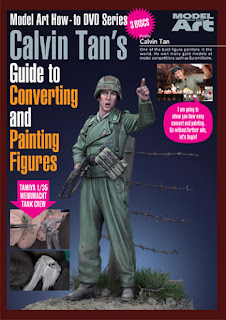Alpine Miniatures - Panzerschütze LSSAH Kursk 1943
.
Placing aside the Landser bust for the moment, my evenings from the past two weeks have been preoccupied with a new painting assignment from Alpine Miniatures. It's almost an irresistible urge for me not to inaugurate the new year with this upcoming offering sculpted by a new Korean sculptor Lee Sang Min. All components of the figure came together perfectly during the dry fitting. For ease of painting, I opted to leave the right arm and hands detached.
This project also marks a landmark attempt to render intricate camouflage patterns using Jo Sonja acrylics; which I must say handles just as well as Vallejo. The paramount focus is to control the fluidity and opacity of the paint so that a homogeneous spread of paint can be achieve for a smooth finish. That is where the acrylic retarder comes in handy in improving the paint flow and extending the working time of the paint.
The oak leaf camouflage pattern was painted with a brown color base before indicating the key regions with medium green. Dark green was then carefully applied to define the contours of the pattern, giving it its trademark appearance. The bass cartridge of the projectile round was simulated by airbrushing clear orange followed by clear blue over a silver base.
That is all of the work that's been done so far on the first figure with only the P-38 holster left to be attached at the waist. Hopefully I could furnish some updates on the second figure when circumstances permit.
Cheers,
Calvin



















4 comments:
Camouflage was painted very perfectly. It's the best work I have ever seen before in this scale.
Best regards, Pavel.
Awesome job Calvin, do you use filters to bring the uniform together of just paint the patten and then high light and shade? It has been a long time that i have asked any questions. Put I still follow all of your work.
Curtis Towers
Always an inspiration to see your work. Fantastic"
Hi All,
thank you for the kind words and compliments.
Curtis,
more frequent than not two things are happening at once; consideration to the shape of the pattern and deciding on the right tone and hue to place them according to the topography of the form in relation to the lighting. The homogeneous effect is principally created by employing analogous colors.
I seldom use filters as they have a high tendency to produce a washed out effect which downgrades the quality of the color hue.
I hope that will adequately answer your question.
Calvin
Post a Comment